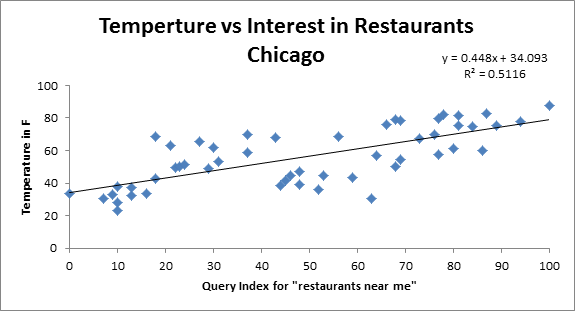Does Weather Affect Site Traffic & SEM Performance?
Omni-channel retail marketers with online sites and offline stores have often wondered about the effect that weather might have on their site traffic (which in turn would affect their paid search bidding strategies). There appear to be three competing hypotheses about weather affecting site traffic: Hypothesis #1: Site traffic is negatively correlated with weather quality […]
Omni-channel retail marketers with online sites and offline stores have often wondered about the effect that weather might have on their site traffic (which in turn would affect their paid search bidding strategies). There appear to be three competing hypotheses about weather affecting site traffic:
- Hypothesis #1: Site traffic is negatively correlated with weather quality — the better the weather, the lower the site traffic as people like to get out and buy products in store (substitution effect).
- Hypothesis #2: Weather has little to no effect on site traffic because surfing online shouldn’t depend much on weather (independent).
- Hypothesis #3: Site traffic is positively correlated with weather quality (synergistic).The theory here is that, when the weather is good, many people think about the store but start their searches online. A good fraction of these searches end with online purchases; as a result, weather quality is directly correlated with online site traffic.
The effect of weather on sales has been studied in the past. A paper from the Federal Reserve Board of Governors dealt with it at length and had several interesting findings. Most notably, it found that good weather had positive effects on sales for restaurants, durable goods, automotive and apparel, among other sectors.
Not surprisingly, food and gasoline sales are not affected by weather, as people need both regardless of weather. However, while this paper dealt with offline sales, it did not touch upon online sales and the online-offline substitution effect. It was this gap that motivated my analysis.
Before I get started, I want to highlight the fact that this is a very preliminary study with a very small sample size, both in terms of advertisers as well as DMAs studied. However, despite these limitations, the results are quite compelling.
Weather Affects Restaurant Searches
First, I looked at the connection between weather and restaurant searches by taking weekly weather data and mapping it with Google Trends data for “restaurants near me” in Chicago. This is an “obvious” case where we should see a connection between weather patterns and a localized search for restaurants.
Better weather would prompt more people to eat outside in restaurants, especially in a place where the weather patterns show large fluctuations. In a sense, this is our control where we should expect to see a connection.
The regression shows a clear connection between temperature and restaurant searches. Note that we have not controlled for other factors such as seasonality and holidays here. Despite that, the crude regression explains 51% of the variance with statistical significance (significant p values). This appears to validate the offline effect of temperature seen by the Fed researchers.
Weather Affects Retail White Goods & Construction Verticals
Next, I took the weekly website visitor and sales data for a set of retailers in the white goods and construction verticals and looked for patterns of site activity in 4 DMAs — three on the East Coast, where the season and temperatures vary significantly over the year, and one in Los Angeles, where the temperature and weather patterns are more stable.
Here, too, we can visually see a correlation (76%), even just looking at day-level of data without controlling for seasonality.
Using a dummy variable-based regression approach, I then investigated the role that weather conditions like snow, fog and rain play in website traffic and sales. Interestingly, in all East Coast DMAs, rain did not affect sales, but snow affected sales representing 11-15% of website sales. The graph below gives the intuition behind it.
Note that for days where the temperature was similar, the weeks with no snow (blue dots) produced more sales than when there was snow (red dots). For most East Coast DMAs, snow during the week lowered sales by between 10 and 15%. This effect disappeared in Los Angeles. Interestingly, rain did not have any effect in any of the DMAs investigated.
Key Takeaways
While this analysis is very preliminary and over a small sample size, it is quite apparent that temperature and adverse weather conditions (snow) do have an effect on website sales for some omni-channel marketers. Perhaps what is most interesting is that online and offline sales appear to be affected by weather the same way (i.e., online-offline sales appear to be synergistic).
Good weather motivates people to buy goods both online and offline. The data seem to validate the third hypothesis above, i.e., that many offline conversions begin with an online search, a fraction of which convert on site itself, another fraction of which end at the store.
Snow has a big effect on site sales. In the 4 DMAs that I investigated, snow had a statistically significant effect in reducing sales by 10-15% from the site’s average. Interestingly, rain did not affect site sales.
Finally, it is worth considering weather forecasts as part of your bidding strategy (for at least some verticals). This would especially be the case for snow days, when sales drop significantly. However, it remains to be seen if a bidding strategy factoring in weather would have a significant impact on SEM performance. If you have factored weather into your search engine bid management strategy, do share your story!
Opinions expressed in this article are those of the guest author and not necessarily Search Engine Land. Staff authors are listed here.
Related stories
New on Search Engine Land


